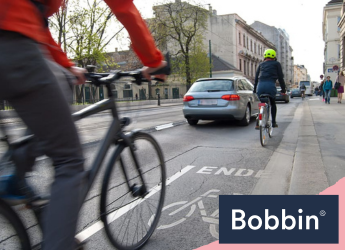Rules for Using a Cycle Lane in the UK
Offering a safer and more efficient route, cycle lanes in the UK cannot be underestimated. But to capitalise on the benefits of these dedicated paths, cyclists must adhere to the rules.
So in this blog, we will delve into the essential rules and etiquette that every bike rider must follow. Gear up, and let’s pedal our way through the dos and don’ts of using a cycle lane in the UK.
Cycle Lanes in the UK

Cycle lanes are designated sections of the road specifically allocated for cyclists. They provide a segregated space that separates them from other vehicles. These dedicated paths ensure the safety and efficiency of cycling as a mode of transport.
In the UK, there are different types of cycle lanes:
- Mandatory cycle lanes: These are marked with a solid white line. They are indicated by a blue sign with a white bicycle symbol. Cyclists are legally required to use these lanes when they are present.
- Advisory cycle lanes: These lanes are marked with a broken white line. Like the mandatory lane, they are indicated by a blue sign with a white bicycle symbol. Additionally, they provide guidance and suggest a space for cyclists to use.
- Segregated cycle lanes: These lanes are physically separated from motor vehicle traffic. In most cases, through barriers, curbs, or other means. They provide a higher level of safety and are often found in urban areas.
Markings, signs, and symbols are essential for effective communication and smooth traffic flow. Commonly used markings in cycle lanes include:
- solid and broken white lines
- symbols indicating the start or end of a lane
- bicycle logos
These visual cues help cyclists understand the boundaries of the lane. They indicate the beginning and end of the lane and alert other road users to the presence of cyclists. Understanding and respecting these markings and signs is vital for maintaining order. Most importantly, for ensuring the safe use of cycle lanes in the UK.
Rules and Etiquette for Cyclists in Cycle Lanes

(Image Credit: Wikimedia Commons)
Here are some essential rules to keep in mind:
- Always ride on the left side of the cycle lane, allowing faster cyclists to overtake safely on your right.
- Show your turns and changes in direction using hand signals. This will give motorists and fellow cyclists ample notice of your intentions.
- Adhere to traffic lights and stop signs, and follow the rules at junctions. Doing so will help avoid accidents and maintain a smooth flow of traffic.
- Keep a safe distance from pedestrians using shared paths. Also, be mindful of other cyclists to prevent collisions.
- When overtaking slower cyclists, ensure it is safe to do so by checking for oncoming traffic. You’ll also want to give them enough space. Pass at a reasonable speed, maintaining a safe distance.
- Equip your bicycle with adequate front and rear lights. Wear reflective clothing during low-light conditions. This enhances your visibility to other road users, reducing the risk of accidents.
Adhering to these rules and adopting responsible cycling behaviour is a must. This habit can create a safer environment for cyclists and others using cycle lanes in the UK.
Responsibilities of Other Road Users

(Image Credit: Wikimedia Commons)
Motorists also have important responsibilities when encountering cycle lanes in the UK. Here are some key points for drivers to keep in mind:
- Motorists must refrain from parking, stopping, or driving in designated cycle lanes. These lanes provide a safe space for cyclists.
- Before opening car doors, it is crucial for drivers to check their rearview and side mirrors. This ensures no cyclists are approaching. Opening doors without caution can result in accidents and injuries to passing cyclists.
- Motorists should be mindful of cyclists’ right of way. This is especially true at intersections and when making turns. Yield to cyclists when required, giving them sufficient space and time to pass safely.
Common Mistakes to Avoid

Cyclists should be aware of common mistakes to ensure their own safety and that of others. Here are some mistakes to avoid:
Riding in the wrong direction
Cycling against the traffic flow increases the risk of collisions on the road. Always ride in the same direction as other vehicles.
Not checking blind spots
Failing to check blind spots before changing lanes or overtaking is also a mistake. For one, this can result in severe road accidents. Always stay vigilant. Look over your shoulder to ensure there are no vehicles or pedestrians in your blind spots.
Overtaking dangerously
Attempting risky overtakes can lead to collisions and injuries. Exercise caution and overtake slower cyclists only when it is safe to do so.
To promote safe cycling practices, remember to:
- always ride in the correct direction
- regularly check blind spots
- exercise patience when overtaking
Prioritise safety to enjoy a smoother cycling experience in cycle lanes.
Round-up
Understanding and adhering to the rules for using a cycle lane in the UK is crucial. In particular, following the Highway Code and relevant regulations. Embracing these rules allows cyclists to contribute to promoting responsible cycling behaviour.








